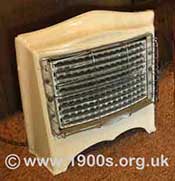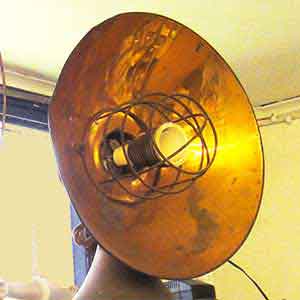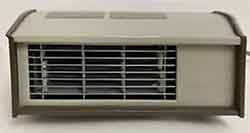Electric fires, mid-20th Century UK

The earliest electric fires heated by passing electricity through coils of wires so that they become hot enough to radiate heat into a room. Later designs incorporated a fan which blew hot air into the room. This page considers the advantages and disadvantages of both types from the viewpoint of users in times when central heating was unknown in ordinary houses..
____
By the webmaster: her early recollections with further research and discussions with others who lived at the time
Hot wire radiant electric heaters
Radiant electric heaters became widely available in the 1950s. They were popular because they could be moved from room to room, wherever there was an electric socket, whereas the earlier gas fires could not.
However, because electric fires worked by radiating heat out into the room, it was important to position them carefully, as they could scorch anything too near. There was always some sort of thick wire shielding over the hot wires, as shown in the following image, but the heater could still be knocked over and burn the floor or carpet or even a nearby person.

The most common type of electric fire in the 1940s and 50s
A low-powered electric heater of the sort shown in the following image was also in use, often in bathrooms and toilets, said to "Just keep the chill off the room". It wasn't very successful in this as bathrooms and toilets did not have electric sockets, so doors had to be left open to accommodate trailing leads. When I was a child I was always cold in the toilet, although fortunately not so in our bathroom which housed the hot tank and was over the boiler.

A low powered electric heater often left on in a room to take the chill off.
Fan heaters
I don't remember fan heaters until the 1960s, although they may have existed before. They were welcome in that they produced instant heat and warmed the air, rather than things in the room which in turn warmed the air. However, they were noisy, relatively expensive to run and one noticed the difference immediately when they were turned off. Nevertheless, their advantages are such that they are still in widespread use today.

Domestic fan heater
Advantages and disadvantages of heating by electricity
Electric fires could warm a room nicely if put on well in advance, and they didn't cause drowsiness like paraffin heaters and coal and gas fires because nothing was burning to use up the oxygen in the air. If they were rated at the magic 3 kw (kilowatts) they could even make a room too warm, but the moment they were turned off, it felt cold, irrespective of what the actual temperature was because of the sudden cut-off of the radiant heat.
Electric fires did not cause condensation and were very drying. Although this was useful for drying wet washing in bad weather, the dry air, particularly when combined with radiant heat, made skin very dry and itchy.
Nowadays of course heating by electricity is very much in favour because it does not directly produce greenhouse gases - indirectly in its production is another matter, but that is not for this page. Before the later years of the 20th Century, though, no-one gave a second thought to such things as global warming was not an issue.
Concluding remarks
Having lived through the 1940s and 50s, I can confirm that there was no really satisfactory way of heating other than central heaing which was only available in up-to-date public buildings like libraries, offices and schools. I was always either too cold or too hot on one side and cold on the other at home in winter.
| sources | webmaster | contact |
Text and images are copyright
If you can add anything to this page or provide a photo, please contact me.



